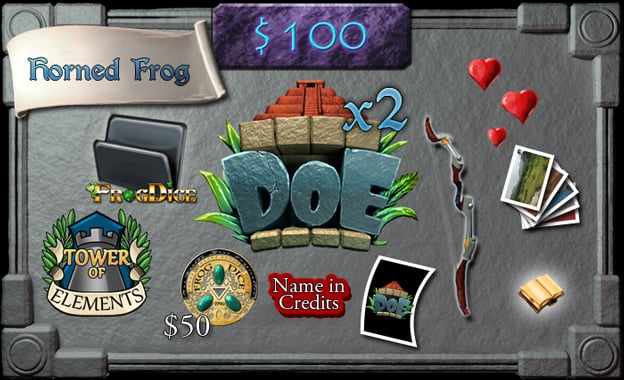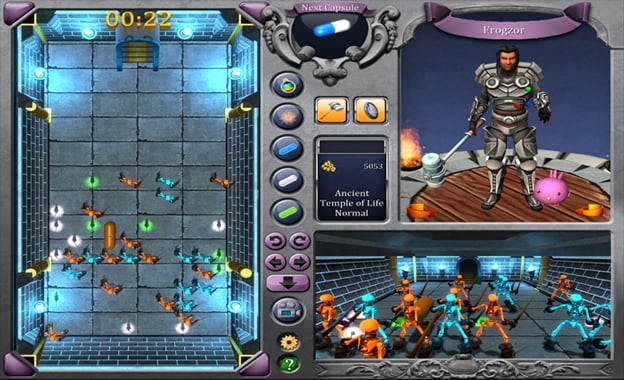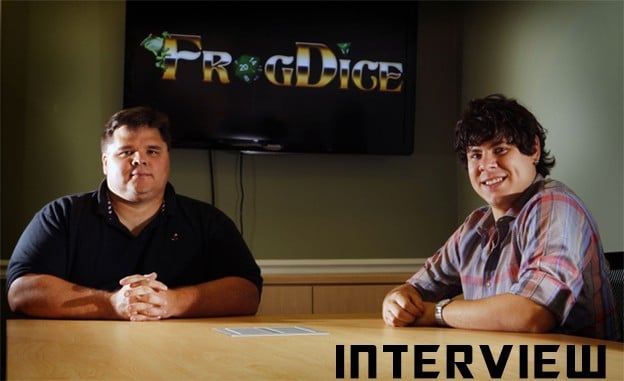From Pollywog to Powerhouse: An Interview With Michael Hartman of Frogdice Games
After nearly getting lost in what seemed to be a never-ending sea of road construction, I finally made a call to Frogdice Games HQ in Lexington, Kentucky. The voice on the phone was none other than the company’s owner/creator Michael Hartman. He assured me that everything was going to be fine and then talked me into the parking lot of their offices. At the top of the stairs leading into Frogdice’s suite, Michael was waiting, followed closely by his wife Pang (creative director and lead designer). I was greeted with a handshake and an offer of hot coffee, which I was more than happy to consider following my trek through a maze of orange barrels and road cones.
Michael poured me a cup of fresh-brewed java and then took me on the grand tour of the office. He introduced me to all the full-time staff and even one of the interns, Leah Hatch (called Pollywogs in Frogdice World). He showed me where Adam Sullivan, the design artist, worked and some of the character cells and art for past and upcoming projects. We went into the developer’s suite where Collin Brooks (one of the programmers) was working his way through 3D world models for their newest project. Michael then showed me some of their past projects and we talked about how they were received, and then he showed me into the second developer’s suite where he had an early build of Dungeon Of Elements – their newest project releasing in August – pulled up and ready for me to play.
I was excited about this. We had been communicating by email for several weeks and he had already given me the lowdown on how DoE was going to play out. It’s an amalgam of character design, RPG, and puzzler all rolled into one great game. I burned my way through several levels and then he gave me the “keys to the kingdom”…I’m talking about the developer codes, which unlocked everything in the game. At that moment, I realized that I was definitely going to be buying this game when it came out. I played on for a few minutes before we finally decided to move into the conference room for our interview.
It was what I expected. There was a large table in the middle of the room with a conference phone in the center and chairs all around. But there was one thing that caught me by surprise. One whole wall of the conference room had been converted into a dry-erase wall for the team to brainstorm their ideas and try to give them shape and definition as they worked. It was beautiful to see all the great ideas mapped out on one giant wall-space. So, after I stopped marveling at the genius on the wall before me, we (Michael, Pang, and myself) all sat down to start talking about…well, everything.

Travis: So, Michael, you guys have been around since 1996, right?
Michael: Yes. Threshold was our first title and it launched in 1996 while I was still in law school in Georgia.
Travis: That’s a long time in game-world. Considering that so many major-label game studios have either fallen off the map or gotten the axe, what do you think attributes to Frogdice’s success in the industry?
Michael: Our gamers. We have such a great base of hardcore fans and we love them all dearly and try to share that with them whenever we can. I mean, we’ve even gone so far as to add player-created characters into the canon of the Threshold world and subsequent games also.
Travis: Speaking of which, while we were playing the early build of Dungeon of Elements, you mentioned that all of your games fall within the lore of Threshold.
Michael: We have actually worked all of our titles into the myths and lore of Threshold. That gave us lots of options and bonuses as well. For example, using the specific lore of one world gave us the opportunity to build up our assets. Not just in the monetary sense but in games assets as well. We have been able to build up a hefty bestiary and database of character designs that we continue to use and tweak as the games grow and give way to other games.
Travis: That brings me to the concept of writing. Who does most of the writing for you?
Pang: Actually, I kind of do most of the writing. I come up with the ideas. Then we all sit around this table and everyone else tells me whether the idea sucks or not! (laughs) Then we decide what stories we are going to go with and the team helps me to refine it to what gets produced. That’s what’s on that wall behind you, actually. It’s where we brainstorm everything.
Michael: She’s definitely the creative driving force around here. I just kind of help steer the ship, really.
Travis: Well, I have to tell you that I love what I have seen so far. Which brings me to a recent experience for you all. You just got back from PAX East not long ago, right?
Michael: Right. Man, that was a crazy trip.
Travis: I wanted you to tell me what it was like to be a small frog in a huge pond, as it were.
Pang: It was awesome! The staff there was great and being part of the Indie Megabooth was more than we ever could have imagined.
Michael: Yeah, if it hadn’t been for the staff we may have not gotten to eat or use the bathroom. It was great, the convention was great, and the staff was amazing. They were a huge help.
Travis: So the reception was good for Frogdice then?
Pang: Unbelievable, it was incredible how people would come to actually see our stuff and not the just wait in line for something else and stop by out of boredom.
Michael: Just to give you and idea, we did some calculating after it was all said and done. Every 84 seconds we either sold a copy of Tower of Elements or got a pre-order for Dungeon of Elements. It was insane. So really, if it hadn’t been for the PAX staff, we would never have gotten to leave the booth at all.
Travis: That is an awesome thing to hear. I love when indie game companies receive a warm welcome and a horde of interested new gamers. It seems to me that indie games are the way the industry is really going anyway.
Pang: I agree. And I think it’s because we can take risks that the big companies can’t. We can have an idea and feel like we are the only people on Earth that would ever want to play a game we make, but because we love the idea and the team sees the potential in it, we make the game. Big companies don’t have the luxury.
Michael: I mean, all of our risks are calculated but Pang is right, we couldn’t do what we do if we had the pressures of a larger publisher breathing down our necks.

Travis: Well, it seems to be working for you guys so far. You have been around for seventeen years and are still growing. I think that shows that the risks you all have taken have definitely paid off.
Michael: Thankfully, when I left corporate law to start a video game company everyone literally thought I was nuts. I mean, they seriously thought I had lost my mind, but I knew it was what I loved and Threshold already had a bunch of players and was building a strong community so I figured I would go for it. It’s how Pang and I met, actually.
Pang: Yep. I was a Threshold player studying law in Vermont when I started playing. The rest is history, really.
Travis: So, I guess you really do give back to your gamers. (all laugh) One thing I have noticed about your games is that you have managed to create endearing titles that people want to play and have been able to bring along hardcore fans as well as having a lot for casual gamers to do. That’s a crazy dichotomy when you think about it. How do you all manage that?
Pang: Well, we are both gamers. We love all kinds of games and we try to keep that in mind when we go into the design phase of any project.
Michael: Definitely. We want to make sure that there is something for everyone. It’s sometimes hard not to get carried away with ideas, but we try really hard to get inside the mind of both our avid gamers as well as our casual gamer base and really analyze what they would like to play or how they would like to play.
Pang: That’s another thing a lot of people don’t know about game development. There really is a lot of science and psychology that goes into it. Michael tries really hard to study up on the trends and talks to gamers about what they want or what they would like to see.
Michael: I also try really hard not to get carried away with that and forget to make the games fun. That’s what it is all about for me anyway. I want to make games that are fun to play. That’s what I think keeps people coming back to us.
Travis: So, has social media played a role in your studies of the trends in the industry?
Michael: Oh man, social media has been the biggest help to us, but it’s one of the things we have to be careful with. You can’t say anything anymore without people on Facebook or Twitter just blasting you.
Pang: But at the same time, you have to be tapped in. You can’t not be tapped in to that.
- Page 1
- Page 2
